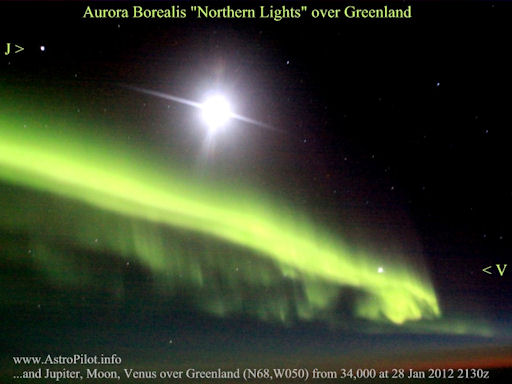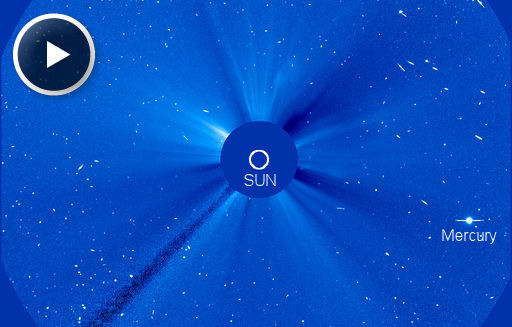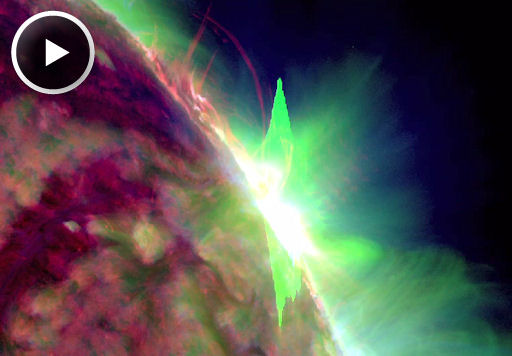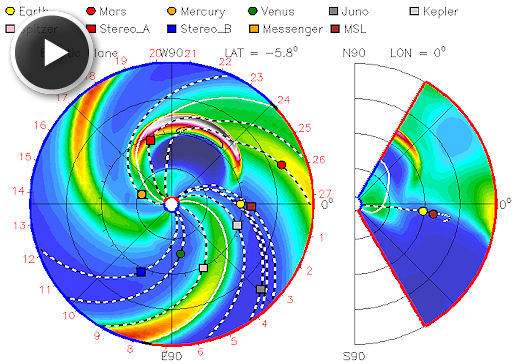JUPITER AND THE MOON: When the sun goes down tonight, step outside and look up. Jupiter and the nearly-half Moon are gathered together less than 10o apart. It's a beautiful sight, and a nice way to end the day.
On Jan. 28th, pilot Brian Whittaker was flying 34,000 feet over Greenland when he saw the Moon approaching Jupiter above a vibrant blanket of auroras:
"The bright green aurora made the proximity of Jupiter, the Moon, and Venus very pretty," says Whittaker. "I can hardly wait for the closer conjunctions in late February and mid March!"
more images: from Peter Rosen of Abisko, Sweden; from Daryl Pederson of Kihei, Maui, Hawaii; from Manfred Molkenthin of Osterholz-Scharmbeck, Lower Saxony, Germany; from Luis Argerich of Mercedes, Buenos Aires, Argentina
RADIATION STORM: Accelerated by Friday's X-flare, energetic protons from the sun are still swarming around Earth on Jan. 29th. The radiation storm ranks S2 on NOAA scales, which means it is not a severe storm. Nevertheless, it can still affect spacecraft and satellites at the nuisance level. Click on the image for an animated demonstration:
That was a coronagraph image from the Solar and Heliospheric Observatory (SOHO). The many speckles and streaks are energetic protons striking SOHO's onboard digital camera. Stronger radiation storms (S4 to S5) can fill images like these with "snow," rendering them useless for normal operations. The current storm will probably subside later today and restore SOHO's clear view of the sun.
FRIDAY X-FLARE: Departing sunspot 1402 unleashed an X2-class solar flare on Jan. 27th at 18:37 UT. NASA's Solar Dynamics Observatory recorded the extreme ultraviolet flash:
Sunspot 1402 is rotating onto the far side of the sun, so the blast site was not facing Earth at the time of the explosion. Nevertheless, energetic protons accelerated by the blast are now surrounding our planet, and an S2-class radiation storm is in progress.
The explosion also produced a spectacular coronal mass ejection (CME). A movie from the Solar and Heliospheric Observatory shows the cloud racing away from the sun at 2500 km/s or 5.6 million mph. Work by analysts at the Goddard Space Weather Lab shows that the CME will just miss Earth when its edge passes by our planet on Jan. 30-31. Click to view an animated forecast track:
The cloud will deliver a glancing blow to Mars on Feb 1st and a nearly-direct hit to NASA's STEREO-Ahead spacecraft on Jan. 29th. Solar flare alerts: text, voice.

![]()
Solar wind
speed: 394.6 km/sec
density: 0.5 protons/cm3
explanation | more data
Updated: Today at 1756 UT
![]()
X-ray Solar Flares
6-hr max: B3 1322 UT Jan29
24-hr: B7 0604 UT Jan29
explanation | more data
Updated: Today at: 1800 UT
![]()
![]()
![]()
Daily Sun: 29 Jan 12
![]()
![]()
None of the spots on the Earthside of the sun pose a threat for strong flares. Credit: SDO/HMI
![]()
![]()
![]()
Sunspot number: 34
What is the sunspot number?
Updated 28 Jan 2012
Spotless Days
Current Stretch: 0 days
2012 total: 0 days (0%)
2011 total: 2 days (<1%)
2010 total: 51 days (14%)
2009 total: 260 days (71%)
Since 2004: 821 days
Typical Solar Min: 486 days
Updated 28 Jan 2012
The Radio Sun
10.7 cm flux: 115 sfu
explanation | more data
Updated 28 Jan 2012
![]()
![]()
![]()
Current Auroral Oval:
![]()
Switch to: Europe, USA, New Zealand, Antarctica
Credit: NOAA/POES
![]()
![]()
![]()
Planetary K-index
Now: Kp= 0 quiet
24-hr max: Kp= 2 quiet
explanation | more data
![]()
Interplanetary Mag. Field
Btotal: 4.3 nT
Bz: 1.1 nT south
explanation | more data
Updated: Today at 1757 UT
![]()
![]()
![]()
Coronal Holes: 29 Jan 12
![]()
![]()
Earth is inside a solar wind stream flowing from the indicated coronal hole. Credit: SDO/AIA.








